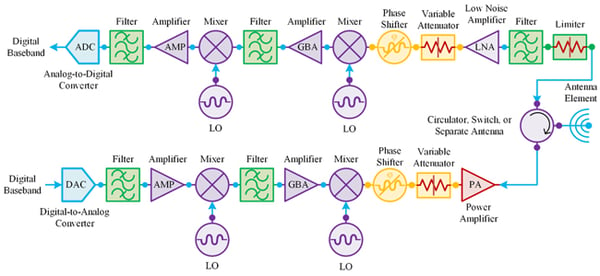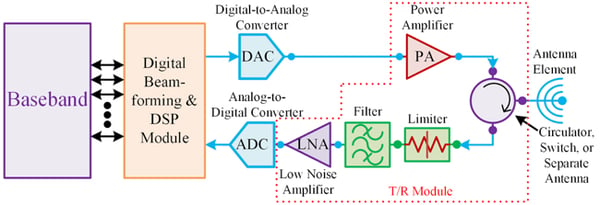Digital beamforming (DBF) technologies are of growing interest in satellite communications as a solution to the challenges of delivering high throughput satellite (HTS) payloads paired with flexible ground terminal technology. Handling the new requirements of low earth orbit (LEO) and medium earth orbit (MEO) satellite constellations is a key goal of digital beamforming. Though Digital beamforming offers unique advantages in real-time reduction in co-channel interference and delivering multiple beams, the heightened complexity of the digital beamforming payload poses many real challenges and even disadvantages for some applications compared to phased-array antenna systems.
DBF Block Diagram and Components Discussion
In a typical analog beamforming (ABF) antenna system, each antenna element is fed a signal that passes through an analog signal chain. The baseband analog signal is passed to (transmission) and from (reception) the baseband to intermediate frequency (IF) frequency translation hardware. Subsequently the IF signals are then passed to (transmission) and from (reception) the RF frequency translation hardware, which is then fed to (transmission) and from (reception) the phase and amplitude shifting hardware. Following phase and amplitude adjustment for the given antenna element, the signals are fed to the RF front-end (RFFE) hardware and then through a circulator, switch, frequency duplexer, or there are separate transmit and receive antennas.
 Fig 1. A typical analog RF signal chain for a single antenna element
Fig 1. A typical analog RF signal chain for a single antenna element
Depending on the separation and signal quality requirements for the baseband frequencies, IF, and RF, there may be multiple IF stages comprised of mixers, local oscillators (LOs), and filters at each stage. As mixers and LOs are highly sensitive to temperature variation, and in the case of resonators, even shock and vibrations, these components often require thermal management systems to ensure they operate within a strict temperature range. This is also often the case for amplifiers, phase shifters, and some filter technologies. Hence, analog beamforming hardware and RF hardware generally requires substantial environmental protection and precise temperature control (mainly heating for satellites) for the components to meet performance requirements.
 Fig 2. A digital beamforming (DBF) signal chain for a single antenna element
Fig 2. A digital beamforming (DBF) signal chain for a single antenna element
Advanced DBF systems essentially replace all of the baseband and IF analog components with digital signal processing (DSP) modules, field programmable gate arrays (FPGAs), and/or general purpose processors (GPP). Digital channelizers, also known as polyphasers, are also used to handle multiple access user (MAU) frequency division (FD) sub-band signals, and converts these signals into a single sample stream. In this way, much of the analog hardware in a satellite communications payload can be replaced with highly integrated digital components, that are often smaller, lighter, lower cost, and software reprogrammable.
In many cases the digital hardware for satellite communications are made of application specific integrated circuits (ASICs) in addition to space-grade FPGAs, and central processing units (CPUs).
Advantages of DBF
With a DBF system, the DSP, channelization, upconversion/downconversion (frequency translation), modulation, beamforming, sampling, and synthesis operations on the RF signals can be done within the digital domain. This allows for highly energy efficient processing that can be “upgraded” with software or reconfigured if there is a change in mission requirements. Reconfiguring analog hardware is generally very limited given the stringent and precise design requirements for most analog signal chains for space applications. Hence, most satellite communication payloads with analog signal chains are limited to their original design parameters.
Given that DSP can be actively performed with advanced DBF systems, effects such as digital predistortion (DPD) can be applied to transmit signals to help reduce the intermodulation distortion (IM), nonlinearities, and other signal degrading aspects of the transmit signal chain. These effects can dramatically improve the linearity of the transmit signal, correct for phase/amplitude errors, and optimize the communication link for a target ground station. These adjustments can even be made to compensate for power amplifier (PA) device aging or aging of thermal management, bias circuitry, or other components that would otherwise cause out of specification performance of the transmit signal chain. The results of which could be extended usable life of the communications payload along with better general throughput performance.
In the case of receiver benefits, advanced DBF systems can be designed to actively respond to interference (or jamming) to avoid desensitization or damage to delicate receiver hardware. DBF systems can also adjust the antenna beams to enhance service for prioritizing critical applications or users.
Generally, digital hardware is more compact than analog/RF hardware, and weighs far less. This allows for much more compact and possibly more efficient thermal management systems. Moreover, DBF systems can also perform antenna auto-calibration, have reduced side-lobs, space multiple beams more closely together, and allow for more flexible antenna resource management than ABF systems.
Another concern of ABF systems is that most analog/RF hardware is custom, hand-made, or otherwise produced in small batches. This brings up concerns for repeatability, availability, and accessibility for massive satellite constellations with hundreds and even thousands of satellites. Also, analog/RF hardware is often sourced from a wide range of vendors with their one unique quoting systems and lead times, which complicates the sourcing of analog/RF hardware compared to a more mass market approach with digital hardware.
Disadvantages of DBF
With a typical ABF system, the phased array antenna may be driven as a sub-array, which would require less RFFE hardware and a simpler design/interconnect scenario. Most DBF systems require individual TRMs for each antenna element, which may increase design complexity and power consumption. DBF technology is also new, as is any hardware deploying DBF technology. Hence, for critical missions there may be reliability and ruggedness concerns that must be addressed for each invested party to have complete buy-in.
In many cases, realizing a DBF system requires a beamforming module that is a custom ASIC. ASICs for DBF are very new, and there may be limited supply or the need to commission a custom ASIC for a given satellite communications payload’s requirements. Moreover, DBF systems are much more computationally intensive, which may lead to the need for additional processing beyond the ASICs; a requirement that scales with the antenna size. This computational demand may result in the need for additional commercial-off-the-shelf (COTS) FPGAs and GPPs, or several custom ASICs. ABF systems, on the other hand, require very little processing beyond the typical baseband processing.
The Analog-to-digital converters (ADCs) and digital-to-analog converters (DACs) used for direct digital synthesis (DDS) and direct RF sampling (DRFS) are much more expensive and less readily available than baseband DACs and ADCs. High frequency ADCs and DACs also come with their own design considerations, including the need for additional filters. Other DDS and DRFS considerations are phase noise, jitter, and spurious-free dynamic range. For instance, reference-clock jitter can be observed as phase noise in DDS systems, and phase truncation may also lead to additional phase error depending on certain code words chosen. DAC quantization and linearity errors produce both added noise and harmonics in the signal, which must be addressed with additional filters or factored into the signal chain budget putting greater constraints on the RFFE hardware.
For high throughput digital circuits, timing is extremely critical between these components, as the margins for timing error shrink with higher throughput, more complex modulation, and digital signal processing requirements. This means that more design effort is needed to ensure timing errors are below an extremely low threshold for critical applications. Moreover, these digital components must also be radiation hardened (rad-hard) and exhibit extremely low incidents of failure, as a complete circuit and within each circuit element.
Conclusion
Though there are many considerations to account for when designing a DBF satellite communications payload, advances in digital hardware are steadily reducing the costs and enhancing the capability of digital components used to build DBFs. Factoring in the economy of scales associated with building hundreds of comparatively low-cost DBF satellite communication payloads and the flexibility of DBF payloads, it is likely that future satellite constellations will be built using various DBF approaches and space-grade DBF technology will become more accessible. The likely result of this is the design of RFFE hardware with constraints driven by the needs of digital systems increasingly prevalent in the RF signal chain.
To learn more, contact our product experts today.
Republished from Microwave Journal: https://www.microwavejournal.com/blogs/28-apitech-insights/post/35492-advantagesdisadvantages-of-digital-beamforming-in-satellite-applications
.jpg)

 News Blog
News Blog


Let Us Know What You Thought about this Post.
Put your Comment Below.